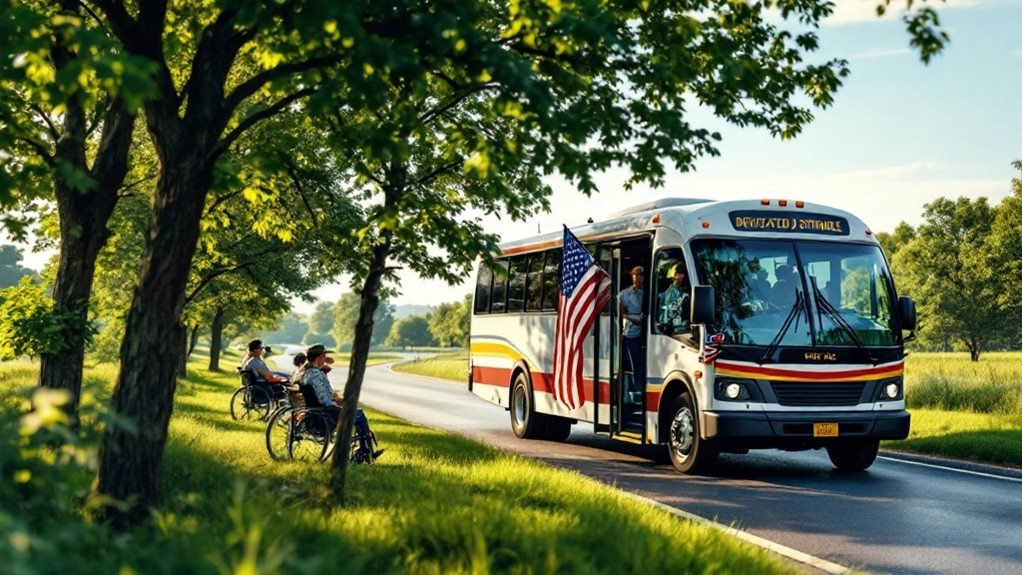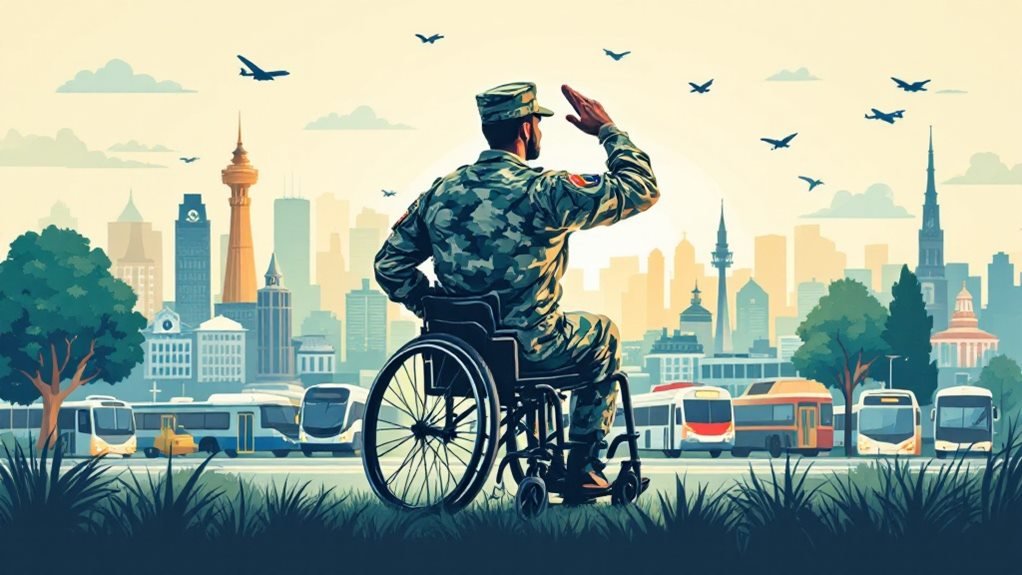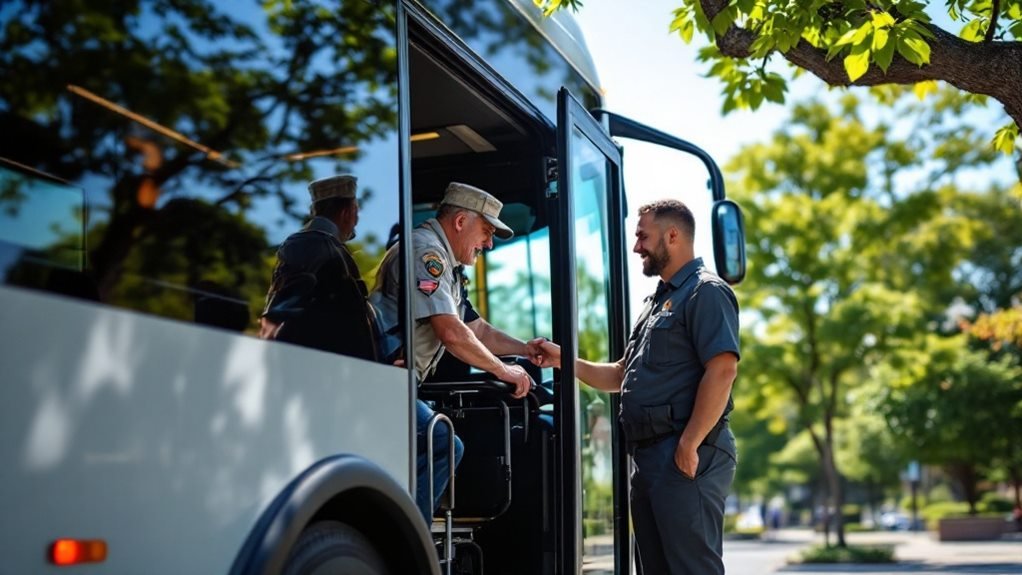To become a transportation provider for veterans, we first need to understand the unique needs of our veteran community, like guaranteeing vehicles are accessible and schedules are flexible. We must research federal and state regulations and acquire essential certifications, including a Commercial Driver's License and potentially defensive driving certifications. Securing the proper insurance coverage is critical for the safety and protection of both veterans and our service. Developing a business plan, equipping and maintaining vehicles, and promoting services thoughtfully will guarantee success. By continuing this journey, we'll discover the steps needed to make a meaningful impact in veterans' lives.
Key Takeaways
- Understand veteran transportation needs, focusing on accessibility, flexible scheduling, and reliable solutions for rural areas.
- Research federal and state regulations for vehicle safety and driver qualifications to ensure compliance.
- Obtain necessary certifications, including a CDL and defensive driving, and complete relevant training programs.
- Secure appropriate insurance coverage, prioritizing liability and medical payments for veteran safety.
- Develop a business plan targeting veterans, including financial projections and potential funding sources.
Understand Veteran Transportation Needs
Understanding veteran transportation needs is essential for providing effective services. As we explore this topic, let's consider the diverse veteran demographics. Veterans come from varying age groups, physical abilities, and service backgrounds, each with unique transportation requirements.
Older veterans might need accessible vehicles, while younger veterans may require flexible scheduling due to employment or education commitments. Recognizing these differences helps us tailor our services to meet specific needs.
Transportation barriers are another critical aspect we must address. Many veterans face challenges such as limited access to public transportation, long travel distances to VA facilities, or financial constraints.
These barriers can hinder their ability to attend medical appointments, access community services, or maintain social connections. By identifying these obstacles, we can develop strategies to overcome them, such as offering door-to-door service or coordinating with local veteran organizations for shared transportation resources.
We must also consider veterans living in rural areas, where transportation options are even more limited. Here, the need for reliable and efficient transportation solutions becomes even more urgent.
Research Relevant Regulations
Diving into the world of regulations, we'll find it's vital to thoroughly research the relevant rules and guidelines that govern transportation services for veterans. By understanding these, we guarantee our services aren't only compliant but also effective in meeting veterans' needs.
Federal regulations set a foundation, outlining the standards we must adhere to when providing transportation services to veterans. These may include vehicle safety requirements, driver qualifications, and insurance mandates. It's important we explore these federal guidelines to grasp the overarching framework that shapes our operations.
Meanwhile, we can't overlook state compliance, which often introduces additional layers of requirements. Each state may have its own specific licensing, operational, and reporting requirements.
Maneuvering through these state-specific rules guarantees we operate legally and responsibly within our respective regions. It's our duty to stay informed about any updates or changes to these regulations, as they directly impact how we serve our veteran community.
Obtain Necessary Certifications
Let's start by identifying the specific certifications required to transport veterans, ensuring we're fully compliant with all necessary standards.
We'll explore the essential training programs and compliance measures needed to maintain high-quality service.
Required Certification Types
Obtaining the necessary certifications is a significant step in becoming a transportation provider for veterans. We need to navigate this process with attention to detail and a heartfelt commitment to service. Certification agencies offer various credentials, and it's essential to select the ones that align with our goals of supporting veterans.
These agencies typically require us to complete specific training programs tailored to the needs of transporting veterans safely and efficiently.
First, let's identify the types of certifications required. A commercial driver's license (CDL) is often necessary, especially if we plan to operate larger vehicles. Additionally, some states require certifications in first aid and CPR to guarantee we can respond effectively to medical emergencies.
We should also consider obtaining certifications in defensive driving, as this enhances safety for our passengers.
Next, we'll explore the certification process. Each agency has its own set of prerequisites, such as background checks and medical evaluations.
We should gather all necessary documentation in advance to streamline our application process. By immersing ourselves in reputable training programs, we not only fulfill these requirements but also enhance our skills, making sure that we're well-prepared to meet the unique needs of our veteran passengers.
Training and Compliance
Beginning the journey to become a transportation provider for veterans requires a thorough understanding of the training and compliance needed to obtain the necessary certifications.
First, we must prioritize driver training. This involves more than just understanding the road; it means learning how to handle the specific needs of veterans. We should seek all-encompassing courses that cover safe driving practices, vehicle operation, and emergency preparedness. Our commitment to quality service starts here.
Next, we need to focus on compliance updates. Regulations can change frequently, and staying informed guarantees we meet all legal standards. We'll need to regularly review federal, state, and local requirements. Maintaining compliance isn't just about meeting legal obligations; it's about ensuring the safety and well-being of those we serve.
By keeping up-to-date with compliance updates, we demonstrate our dedication and reliability.
Let's approach these steps with empathy and precision, understanding that each move we make is in service to those who've served us. It's not just about fulfilling requirements; it's about building a foundation of trust and excellence.
Application Process Overview
As we initiate the application process to become certified transportation providers for veterans, understanding each step in detail is crucial.
Our journey begins with confirming we meet the eligibility criteria. This typically includes having a valid driver's license, a clean driving record, and the necessary vehicle insurance. We also need to pass a background check, which is essential for guaranteeing the safety and trust of our veteran passengers.
Once we've confirmed our eligibility, let's focus on gathering the right documentation. Application tips suggest organizing our paperwork in advance, such as proof of insurance, vehicle registration, and any medical certifications if required. It's helpful to create a checklist to track our progress and confirm no step is overlooked.
Next, we apply for the necessary certifications. This often involves completing specific training programs designed to prepare us for the unique needs of veterans. Staying organized and attentive throughout this process will help us efficiently obtain our certifications.
Secure Appropriate Insurance
As we begin the process of securing the appropriate insurance, it's essential that we first understand the specific coverage requirements necessary for transporting veterans.
We'll then explore various policy options to guarantee we find the best fit for our needs and obligations.
Understand Coverage Requirements
Securing the right insurance coverage is an essential aspect of becoming a transportation provider for veterans. It guarantees that we can offer veteran mobility with safety and reliability at the forefront.
As we focus on transportation accessibility, understanding coverage requirements becomes vital. This step isn't just about adhering to legal obligations—it's about protecting the veterans we serve and ourselves from unforeseen incidents. Our vehicles, which might be specially equipped to accommodate various mobility needs, require coverage that reflects these specialized adaptations.
When delving into coverage specifics, we should consider liability insurance, which covers potential damages or injuries during transport. Extensive coverage safeguards against theft or damage to our vehicles, guaranteeing our operations aren't interrupted.
It's important to verify if medical payments coverage is necessary to handle any immediate medical expenses arising from accidents. We must also confirm our policy covers all drivers associated with our service, considering any necessary background checks and qualifications.
As we navigate these requirements, empathy and diligence guide our decisions, confirming that veterans receive the dependable and secure transportation they deserve. Our commitment to understanding these requirements strengthens our ability to serve effectively and compassionately.
Explore Policy Options
When exploring policy options for securing appropriate insurance, we must focus on selecting plans that best meet our unique transportation needs. As we venture into becoming transportation providers for veterans, it's vital to prioritize the safety and well-being of our passengers.
We need to evaluate policies that offer extensive coverage, including liability and vehicle protection. Identifying funding opportunities can help alleviate the financial burden of securing these insurance options, guaranteeing we can provide the highest quality service without compromising on safety or care.
Our commitment to serving veterans efficiently means advocating for policies that enhance our ability to deliver reliable transportation. We should actively engage in policy advocacy, voicing our requirements and experiences to influence better insurance provisions tailored to our field. By doing so, we contribute to a system that understands and supports the specific needs of veteran transportation providers.
It's important to remain organized and diligent in our search for the right insurance policies. We must scrutinize each option, making sure it provides the necessary coverage and aligns with our mission to serve those who've served us.
Compare Insurance Providers
While starting the journey to secure appropriate insurance, it's vital to thoroughly compare insurance providers to guarantee we select the best option for our transportation services.
Our mission to serve veterans demands that we protect both our passengers and our business. To achieve this, we must explore policy comparisons and evaluate each provider based on their coverage, reliability, and reputation. This process helps us identify the most extensive and cost-effective insurance plans available.
First, let's gather quotes from a variety of insurance companies. This allows us to assess the insurance costs associated with each policy.
We should examine what's included regarding liability coverage, personal injury protection, and any additional benefits offered. Understanding these details confirms that we're adequately covered in any eventuality.
Next, we need to scrutinize customer reviews and testimonials. This step helps us gauge the quality of service each provider offers.
Are claims processed efficiently? Is customer service responsive and supportive? Positive feedback from other transportation providers can guide us toward a trustworthy choice.
Develop a Business Plan
Crafting a thorough business plan is an essential step in becoming a successful transportation provider for veterans. First, let's identify our target market. Veterans in need of consistent, reliable transportation services are our primary focus. Understanding their unique needs and challenges will help us design services that truly make a difference in their lives.
We must consider factors like geographic location, frequency of required transport, and any specific accommodations they may need.
Next, we'll develop financial projections. This involves estimating our startup costs, operating expenses, and potential revenue streams. By creating a clear budget, we can guarantee we've the resources to maintain high-quality service.
We should account for vehicle maintenance, fuel costs, insurance, and driver wages. Additionally, we might explore potential funding sources, such as government grants or partnerships with veteran organizations, to support our mission.
Apply for Provider Status
To effectively apply for provider status, we must diligently gather and prepare all necessary documentation to meet the requirements set by the relevant authorities. This process guarantees we're recognized as capable and committed to serving our veterans.
First, we need to review the provider qualifications, which typically include proof of insurance, valid driver's licenses, and background checks for all drivers. It's essential to have a thorough understanding of these requirements to prevent any delays.
The application timeline can vary, so we should be prepared for a process that may take several weeks to months. We can start by contacting the Department of Veterans Affairs or local veterans service organizations to get the specific details and deadlines.
Staying organized and keeping track of all forms and communications will help us stay on schedule.
Let's approach this task with empathy and a strong sense of purpose. Our goal is to become a reliable transportation provider for veterans, guaranteeing they receive the services they deserve.
Equip and Maintain Vehicles
Guaranteeing our vehicles are properly equipped and maintained is vital to providing safe and reliable transportation for veterans. Our first step is conducting regular vehicle maintenance. This includes scheduling routine oil changes, tire rotations, and brake inspections. By adhering to these tasks, we guarantee transportation safety and extend the lifespan of our vehicles.
We must also verify that all seat belts and safety features are fully operational, as well as verify emergency equipment, like first-aid kits and fire extinguishers, are available and easily accessible.
Next, equipping our vehicles to cater specifically to veterans' needs is essential. We should consider installing features such as wheelchair lifts or ramps to accommodate those with mobility challenges. Additionally, maintaining cleanliness and comfort within the vehicle not only demonstrates respect but also enhances the travel experience for our passengers.
We can't forget the importance of maintaining clear records of all vehicle services and inspections. This not only helps in managing vehicle maintenance schedules but also guarantees that we're meeting any regulatory requirements.
Promote Your Services
Promoting our services effectively is essential to reaching veterans who could benefit from our transportation solutions. We must craft a strategic plan that includes both online marketing strategies and community outreach programs. By doing so, we guarantee that our message reaches veterans and their families, letting them know about the reliable and compassionate transportation we offer.
Firstly, let's focus on online marketing strategies. We can leverage social media platforms to share stories, testimonials, and updates, creating a connection with our audience. Using targeted ads can further help us reach veterans in specific locations. Our website should be easy to navigate, offering detailed information about services, booking procedures, and contact details.
A blog featuring veteran-related topics can also serve as both a resource and a promotional tool.
On the community side, participating in local events, such as veteran fairs and community gatherings, allows us to connect face-to-face. We can partner with veteran organizations to build trust and credibility. Hosting informational sessions or workshops can educate the community about our mission and services.
Conclusion
In our journey to become transportation providers for veterans, we've understood their unique needs, researched the necessary regulations, and obtained essential certifications. We've secured the right insurance, developed a solid business plan, and applied for provider status. We've equipped and maintained our vehicles to guarantee safety and reliability. Now, let's promote our services with passion, dedication, and empathy, assuring that every veteran feels valued, respected, and supported. Together, we can make a meaningful difference.



